Standard [CURRENT]
ASTM E 1546:2024
Standard Guide for Development of Fire-Hazard-Assessment Standards
- German title
- Erstellung von Normen für die Beurteilung von Brandgefahren
- Publication date
- 2024
- Original language
- English
- Pages
- 24
- Publication date
- 2024
- Original language
- English
- Pages
- 24
- DOI
- https://dx.doi.org/10.1520/E1546-24
Product information on this site:
Quick delivery via download or delivery service
Buy securely with a credit card or pay upon receipt of invoice
All transactions are encrypted
Short description
1.1 This guide covers the development of fire-hazard-assessment standards. 1.2 This guide is directed toward development of standards that will provide procedures for assessing fire hazards harmful to people, animals, or property. 1.3 Fire-hazard assessment and fire-risk assessment are both procedures for assessing the potential for harm caused by something-the subject of the assessment-when it is involved in fire, where the involvement in fire is assessed relative to a number of defined fire scenarios. 1.4 Both fire-hazard assessment and fire-risk assessment provide information that can be used to address a larger group of fire scenarios. Fire-hazard assessment provides information on the maximum potential for harm that can be caused by the fire scenarios that are analyzed or by any less severe fire scenarios. Fire-risk assessment uses information on the relative likelihood of the fire scenarios that are analyzed and the additional fire scenarios that each analyzed scenario represents. In these two ways, fire-hazard assessment and fire-risk assessment allow the user to support certain statements about the potential for harm caused by something when it is involved in fire, generally. 1.5 Fire-hazard assessment is appropriate when the goal is to characterize maximum potential for harm under worst-case conditions. Fire-risk assessment is appropriate when the goal is to characterize overall risk (average severity) or to characterize the likelihood of worst-case outcomes. It is important that the user select the appropriate type of assessment procedure for the statements the user wants to support. 1.6 Fire-hazard assessment is addressed in this guide and fire-risk assessment is addressed in Guide E1776 . 1.7 This standard does not purport to address all of the safety concerns, if any, associated with its use. It is the responsibility of the user of this standard to establish appropriate safety, health, and environmental practices and determine the applicability of regulatory limitations prior to use. 1.8 This fire standard cannot be used to provide quantitative measures. 1.9 This standard is used to predict or provide a quantitative measure of the fire hazard from a specified set of fire conditions involving specific materials, products, or assemblies. This assessment does not necessarily predict the hazard of actual fires which involve conditions other than those assumed in the analysis. 1.10 This international standard was developed in accordance with internationally recognized principles on standardization established in the Decision on Principles for the Development of International Standards, Guides and Recommendations issued by the World Trade Organization Technical Barriers to Trade (TBT) Committee.
ICS
13.220.01
DOI
https://dx.doi.org/10.1520/E1546-24
Also available in
Loading recommended items...
Loading recommended items...
Loading recommended items...
Loading recommended items...

